


Lippisch P-13a - $$5.95
As conventional fuels were in extremely short supply by late 1944, Lippisch proposed that the P.13a be powered by coal. Initially, it was proposed that a wire-mesh basket holding coal be mounted behind a nose air intake, protruding slightly into the airflow and ignited by a gas burner.
Lippisch P-13a Ramjet Interceptor
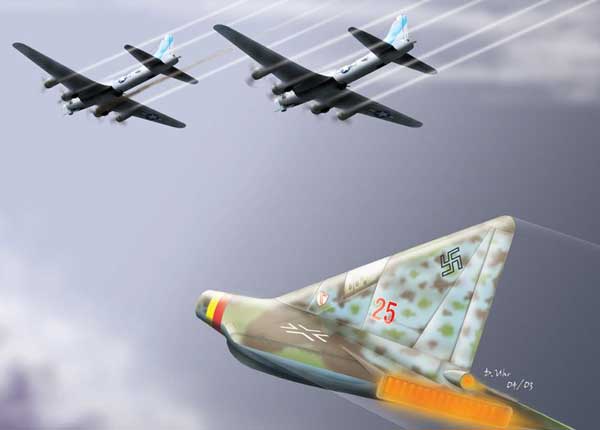
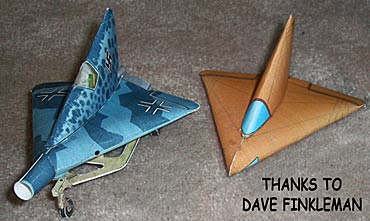
The last most desperate attempts by the Luftwaffe to stop the Allied bomber streams were exemplified by the demand: fighters, fighters, fighters - quick and simple to build, cheap and from easily accessible materials, small dimensions, superior speed compared to enemy escort fighters and firepower. Nearly all aircraft manufacturers and designers in the Third Reich put designs to paper along these lines. Even Dr. Lippisch's ideas during the last year of the war fit into this concept. Of his numerous variants, the Lippisch 13a was actually given serious consideration.
The Lippisch P.13a was an experimental ramjet-powered delta wing interceptor aircraft designed in late 1944 by Dr. Alexander Lippisch for Nazi Germany. The aircraft never made it past the drawing board, with testing of wind tunnel models showing the design had extraordinary stability into the Mach 2.6 range. As conventional fuel was in short supply at the end of the war, the ramjet was to be powered by powdered coal.
It was the end of the war that prevented further development beyond the un powered DM-1 test glider. After the war, Lippisch, working with American aircraft designer Convair, developed and tested the XF-92 based on his designs, leading to the eventual adoption of the F-102 Delta Dagger and its successor, the F-106 Delta Dart
Hate to interupt a busy man, but the literature that comes with the kit doesn't say how the P-13 was to be handled, moved about or launched. Here are my guesses. For flight test, the P-13 would be carried aloft on the roof of the Siebel, like the space shuttle rides on the back of the 747.
Once the P-13 became operational, I'd bet on a towplane pulling it into the air while the P-13 was riding on a two wheeled dolly much like the Me-163. And to lift a just landed P-13 on to the little ground handling dolly, I'd suspect something like the odd but effective little schu dchlepper special fork lift that went out and put just landed Me-163s on their ground transport dollies.
If you can explain this, I promise not to bother you, at least for a while. You might even put the correct answer in the P-13 history piece that prints on the kit to prevent other curious types interupting your work. Thanks in advance, David
Lippisch P-13a
Professor Alexander Lippisch,(see biography below) one of the most dedicated promoters of the flying wing, also tried to create an inexpensive but deadly fighter aircraft that was designed for quick and easy mass production. Apart from his early rocket-propelled tailless designs, Lippisch also developed three advanced flying wings under the designations Li P 12, P 13, and P 13a.
The Li P 12 (below) was an unusual tailless design with an internally
positioned athodyd liquid fuel propulsion unit (a continuous duct or tube which admits air at the forward end, adds heat to it by the combustion of fuel, and discharges it from the aft end). The air intake was
in the nose and the pilot was seated above the combustion chamber.
The undercarriage consisted of a single central wheel and outrigger
skids on the wing tips. The wing area was about 210 sq ft. In August
1944, it was suggested to air-launch the aircraft using a Fw 58
Weihe 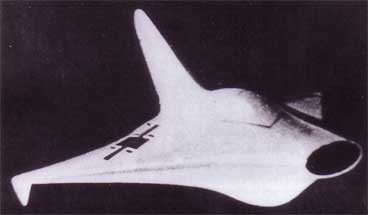 (Harrier)
as a carrier for the first evaluation stage, the Li P 12 being mounted
piggy-back on top of the Fw 58.
(Harrier)
as a carrier for the first evaluation stage, the Li P 12 being mounted
piggy-back on top of the Fw 58.
In order to test the properties of the advanced flying-wing configuration, about fifteen tests of flying scale models were carried out near Vienna commencing on November 28, 1944. Previous wind tunnel tests had confirmed the soundness of the Lippisch configuration, and additional successful tests were carried out in the Spitzerberg hills near Hamburg, Austria.
A few weeks later around Christmas 1944, a full-scale piloted prototype, known as the DM 1 (DM - Darmstadt München Entwurf 1, the first project and the location of its development), was under construction at Prien on Lake Chiemsee in Bavaria. For actual flight testing, the DM 1 was to be mounted on top of a Siebel 204A carrier aircraft.
At a later stage the DM- 1 was to be flown at a speed of 497 mph under the power of a rocket motor. At the other end of the speed range, the aerodynamic characteristics of this little single-seat aircraft were such that a landing speed of only 44 mph was expected.
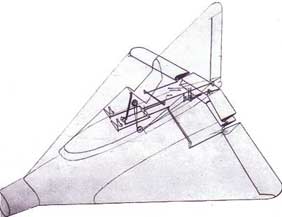 When
Allied tanks appeared on the air field at Prien on May 3, 1945,
the aircraft was nearly complete. Ninety days after the end of the
war in Europe, August 6, 1945, the Americans proposed finishing
the project and test-flying the prototype atop a Douglas DC-3. However,
by the time the DM 1 was completed a few weeks later, the group
was ordered to transfer the experimental aircraft to the United
States for proper evaluation. In January 1950, the DM 1 became the
property of the National Air and
Space Museum (NASM) and was transferred to their storage facility
outside Washington, DC.
When
Allied tanks appeared on the air field at Prien on May 3, 1945,
the aircraft was nearly complete. Ninety days after the end of the
war in Europe, August 6, 1945, the Americans proposed finishing
the project and test-flying the prototype atop a Douglas DC-3. However,
by the time the DM 1 was completed a few weeks later, the group
was ordered to transfer the experimental aircraft to the United
States for proper evaluation. In January 1950, the DM 1 became the
property of the National Air and
Space Museum (NASM) and was transferred to their storage facility
outside Washington, DC.
The projected Li P 13 was originally designed as a two-seater, but later appeared in modified form as the single seat Li P 13a. The leading-edge sweep back had been increased to 60 degrees. The span was 19.7 ft, the wing area was approximately 215 sq ft, and the aspect ratio was calculated at 1.8 !!
The pilot was seated in the narrow leading edge of the large dorsal fin. The solid fuel, in the form of small pellets of lignite (brown coal), was to be carried in a wire-mesh container mounted at a slight angle in the duct that was at an angle to the air stream. The airflow in the lower duct was therefore obstructed, and it was intended to start a progressive reaction with oxygen passing through the fuel. After ignition carbon monoxide was produced by the burning fuel, which combined with the oxygen in the air passing through the upper unobstructed duct section and formed carbon dioxide. This highly innovative system failed to function effectively in disappointing tests, and it was abandoned.
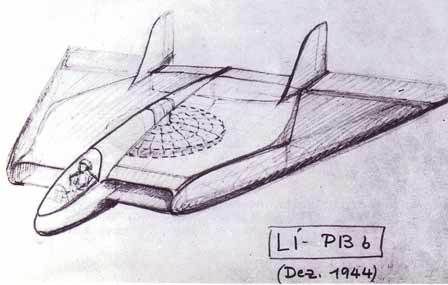 An improved solid-fuel design, the Li P 13b, utilized
a circular basket of oval cross section suspended in the duct and
rotating on its vertical axis at about 60 rpm. The combustion was
started by a gas burner with liquid fuel used to facilitate starting.
An alternate, more easily combustible fuel in the form of coal dust
pellets was proposed, with an oxygen carrying material spread over
the outer surface of the charge.
An improved solid-fuel design, the Li P 13b, utilized
a circular basket of oval cross section suspended in the duct and
rotating on its vertical axis at about 60 rpm. The combustion was
started by a gas burner with liquid fuel used to facilitate starting.
An alternate, more easily combustible fuel in the form of coal dust
pellets was proposed, with an oxygen carrying material spread over
the outer surface of the charge.
The P-13a consisted basically solely of engine and fuel tank with some room provided for the pilot. The pulse engine from Schmidt-Argus, similar to the ramjet, was certainly not a new concept, and the Fieseler Fi 103 flying bomb (right)- better known as the V1 - flew in massive numbers against England with this type of engine.
This engine (called the "Lorin" engine after its inventor) with the wings of the Li P12/13, which could be controlled by flaps in the exhaust flow and ultimately was a flying wing, was called a "Triebflugel" (powered wing) by Lippisch. This was not to be confused with the ramjet-powered (Lorin) "Triebflugel" project of Focke-Wulf. This was a separate helicopter-like vertical takeoff aircraft with everything else operating as with a flying wing. The ramjet operated by itself only after a certain speed had been reached. This process involved ram air entering in through an opening in the front, being mixed with fuel, compressed, ignited and forced out the back.
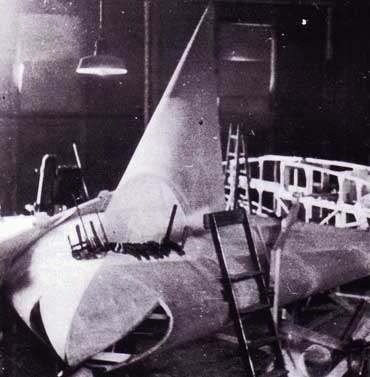 The
P13a (a supersonic fighter) was made of wood, plywood and steel
tubing. One-piece wing of open rib design, cantilever, vertical
and horizontal stabilizer surfaces were hinged, with trim tabs in
the interior portion. There was no fuselage in the normal sense,
the cockpit was located in part within the forward portion of the
vertical stabilizer, in part just behind the forward leading edge
between the two main spars.
The
P13a (a supersonic fighter) was made of wood, plywood and steel
tubing. One-piece wing of open rib design, cantilever, vertical
and horizontal stabilizer surfaces were hinged, with trim tabs in
the interior portion. There was no fuselage in the normal sense,
the cockpit was located in part within the forward portion of the
vertical stabilizer, in part just behind the forward leading edge
between the two main spars.
A window in the lower forward floor provided better view at high angles of attack (during landing at roughly 35 degrees). The triangular vertical stabilizer had a similar profile as the wing. Trimming was accomplished by a manually operated water transfer pump 9 gallons from a rear tank to a nose tank and back. The tricycle landing gear, which could only be retracted on the ground, had a 23 inch travel stroke. No type of armament was planned for this test version; overall, the DM-1 was kept to simple, spartan standards.
There were no complicated, moving parts and this little terror was to be quick and cheap to build. The P-13a fighter being proposed by Lippisch would be powered in part by coal as fuel.
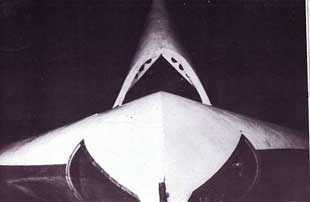
The Flying Coal Oven:
As conventional fuels were in extremely short supply by late
1944, Lippisch proposed that the P.13a be powered by coal. Initially,
it was proposed that a wire-mesh basket holding coal be mounted
behind a nose air intake, protruding slightly into the airflow
and ignited by a gas burner.
Following wind-tunnel testing of the ramjet and the coal basket, modifications were incorporated to provide more efficient combustion. The coal was to take the form of small granules instead of irregular lumps, to produce a controlled and even burn, and the basket was altered to a mesh drum revolving on a vertical axis at 60 rpm. A jet of flame from tanks of bottled gas would fire into the basket once the P.13a had reached operating speed (above 199 mph), whether by using a RATO unit or being towed.
The air passing through the ramjet would take the fumes from the burning coal towards the rear where they would mix under high pressure with clean air taken from a separate intake. The resulting mixture of gas would then be directed out through a rear nozzle to provide thrust. A burner and drum were built and tested successfully in Vienna by the design team before the end of the war.
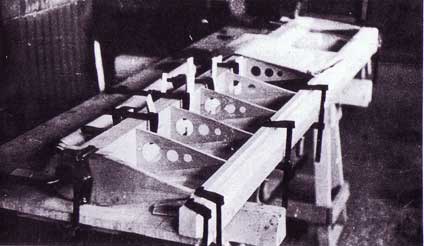 It is not known what armament would have been carried by the P.13a;
the MK 103 cannon would have been too heavy and large for such a
small aircraft and it is possible that one or two large-caliber
machine guns would have been used. The MX 108 (30
mm caliber ), then common to all jet and rocket fighters, would have been
utilized.
It is not known what armament would have been carried by the P.13a;
the MK 103 cannon would have been too heavy and large for such a
small aircraft and it is possible that one or two large-caliber
machine guns would have been used. The MX 108 (30
mm caliber ), then common to all jet and rocket fighters, would have been
utilized.
On 11/12 September 1944 the FFG Darmstadt was destroyed in a bombing
attack and everything pertaining to aircraft and materials which
could be saved was sent elsewhere.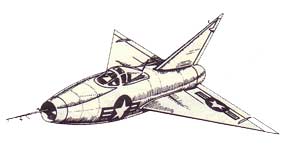
At the end of the war not even the prototype DM-1 test glider had not been finished when it was captured by US forces. It was ordered to be completed by Lippisch's team and was then shipped to the USA where it was test-flown. Reportedly the results were very positive and lessons learned were incorporated into NASA's research aircraft of the 1950s and on.
The Americans shipped the prototype back to the USA for completion and flight testing, and the resulting data were incorporated into the design of the many US delta-wing aircraft which appeared in subsequent years.
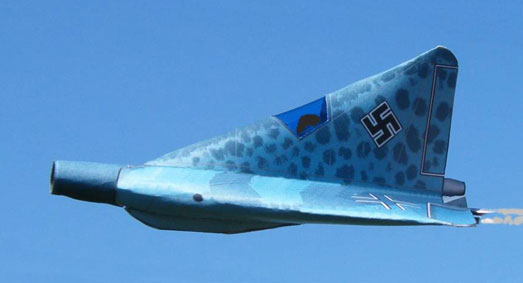 |
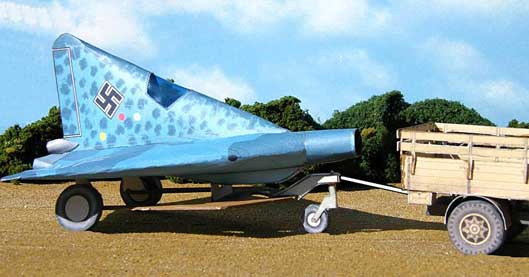 Two great photos of one great model from Bob |
BIBLIOGRAPHY:
Alexander Lippisch was born Nov. 2, 1894 into a highly cultured
family. His father was a creative artist and Alexander apparently
took after his father in art as well as music. During his early
youth he became interested in flying after observing the flights
of the Wright bothers in 1909. He was drafted by the by the military
in early 1915 and in the fall became ill with pneumonia. After recovering
he got a job in aerial surveying with the army. In 1918 he was discharged
from the army and got a job in the Zeppelin factory where he was
appointed to work under Mr. Claude Dornier. Here he studied the
new science of aerodynamics and worked there until the armistices
was signed in 1918.
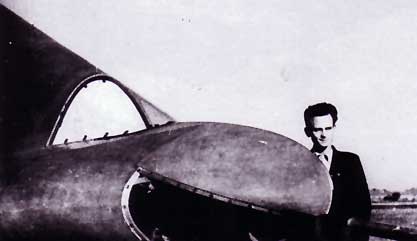 After the war, Lippisch was out of a job and returned home until
1921 when he worked on sailplanes. During the 1920's he was involved
in the design and construction of many sailplanes and gliders. Included
were many unusual designs and swept wing configurations. These designs
led to the tailless aircraft and the delta wing configuration which
Lippisch felt was the configuration of the future.
After the war, Lippisch was out of a job and returned home until
1921 when he worked on sailplanes. During the 1920's he was involved
in the design and construction of many sailplanes and gliders. Included
were many unusual designs and swept wing configurations. These designs
led to the tailless aircraft and the delta wing configuration which
Lippisch felt was the configuration of the future.
Although he never went to college he learned engineering from his
work at the Zeppelin factory under the Claude Dornier. He also conferred
with Professor Ludwig Prandtl one of the foremost aerodynamics of
his time. Based on the work with the delta wing and tailless airplanes
he wrote his Doctor Dissertation to earn his degree.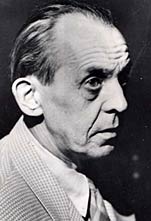
The delta wing and tailless designs led the aircraft using the Walter
liquid-fueled rocket engine. Lippisch was in charge of the airframe
design and Walter was in charge of the engine. The airplane was
designated the Me 163. According to German records 364 Me 163 were
built. The airplane was far ahead of its time and was aerodynamic
clean and was very fast achieving a Mach number of approximately
0.8 in level flight. Due to personality difficulties Lippisch left
Messerschmitt and went to another German research institute at in
1943 Vienna. Austria. Here he worked on designs of advance aircraft
including configurations for operation at Mach numbers above 1.0.
At the end of the war he left Germany and came to the USA under operation paper clip along with other German engineers and scientists. Here he worked for the Navy and finally for Collins Radio. Here his work was supported by the Office of Naval Research and included design work on various wingless and other aircraft including ground effect machines.
In reviewing the work and life of Alexander Lippisch it became apparent
that his work was very creative and much ahead of its time. He apparently
was not bothered by theoretical considerations but was more interested
in the overall picture. Like the Wright brothers whom he admired;
much or his work was cut and try based on an the overall need. As
Lippisch was a product of a different time period his life and work
can not be compared with those of the present time. For this reason
he can not be judged based on present day standards but must be
judged based on his accomplishment of the time.
Reference: Al, The Cedar Rapids Gazette: August 1 to 8 1978. "Alexander Lippisch Man of the Future".
Specifications
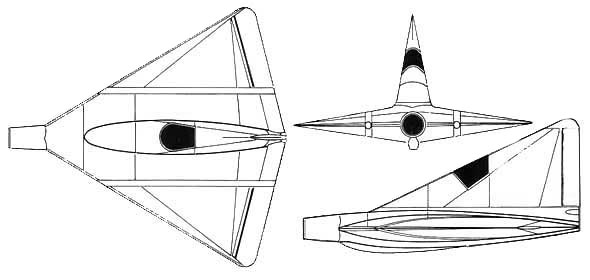 |
Length: 22 ft Wingspan: 19 ft 9 in Height: 10 ft 8 in Wing area: 215 ft² Loaded weight: 5,060 lb Powerplant: 1× Kronach Lorin coal-burning ramjet Performance Maximum speed: 1,025 mph Range: 621 miles Wing loading: 24 lb/ft² |


